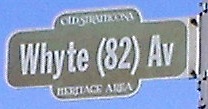Old Strathcona
| Old Strathcona | |
|---|---|

The 1908 Strathcona Railway Station, just south of Whyte Avenue in the centre of Old Strathcona.
|
|
| Location | Edmonton, Alberta, Canada |
| Coordinates | 53°31′5″N 113°29′50″W / 53.51806°N 113.49722°W |
| Area | 5 square blocks |
| Built | 1891-1913 |
| Architectural style(s) | Late Victorian, Edwardian |
| Governing body | City of Edmonton |
| Provincial Historic Area | 2007 |
 |
|
|---|---|
| 82 Avenue, Blue Mile | |
| Maintained by | the City of Edmonton |
| Length | 7.2 km (4.5 mi) |
| Location | Edmonton, Strathcona |
| West end | 114 Street / University Avenue |
| Major junctions |
114 Street, University Avenue, 104 Street, Gateway Boulevard, 75 Street, 50 Street |
| East end | 50 Street |
Old Strathcona is an historic district located in south-central Edmonton, Alberta, Canada. Once the commercial core of the separate city of Strathcona, the area is now home to many of Edmonton's arts and entertainment facilities, as well as a local shopping hub for local residents and students at the nearby University of Alberta. Many of the area's businesses are owner-operated but, chains have also made inroads in the neighbourhood. A good proportion of Edmonton's theatres and live-performance venues are also located in the area. The district centres on Whyte (82) Avenue and has shops, restaurants, bars and buskers.
In 2007, Old Strathcona was named Alberta's second Provincial Historic Area. The district comprises an area of five city blocks from 85 Avenue south to 80 Avenue and from 102 Street west to 106 street.
The Old Strathcona and Area Business Revitalization Zone (BRZ) is a roughly cross-shaped business revitalization zone, extending along Whyte Avenue from just west of 109 Street in the west, to just east of 99 Street in the east, and along Gateway Boulevard from 86 Avenue in the north to University Avenue in the south.
Old Strathcona was once a municipality separate from Edmonton, achieving town status in 1899 and city status in 1907. The City of Strathcona amalgamated with Edmonton in 1912. A large part of the popularity of Whyte Avenue is due to the historical character of its buildings, many of which are one hundred years old. The oldest building is the Strathcona Hotel, built by the railway when it arrived in 1891. Early construction used mostly wood, but this changed in 1902 when the Town of Strathcona passed a bylaw requiring the building of brick buildings in the downtown core to prevent the outbreak of a major fire. Much of the current brick buildings were erected during the 1910–1912 boom that brought thousands of settlers to the Edmonton area from eastern Canada, Britain and continental Europe, U.S. and other parts of the world. Whyte Avenue in the early 1890s was dominated by primitive shack homes and quickly-built pioneer stores, some so primitive, they were built of logs. Within a few years these early structures were replaced by more substantial woodframe two-storey buildings or, in the case of the Ross Block, by a brick building even before the town's anti-fire bylaw.
...
Wikipedia

